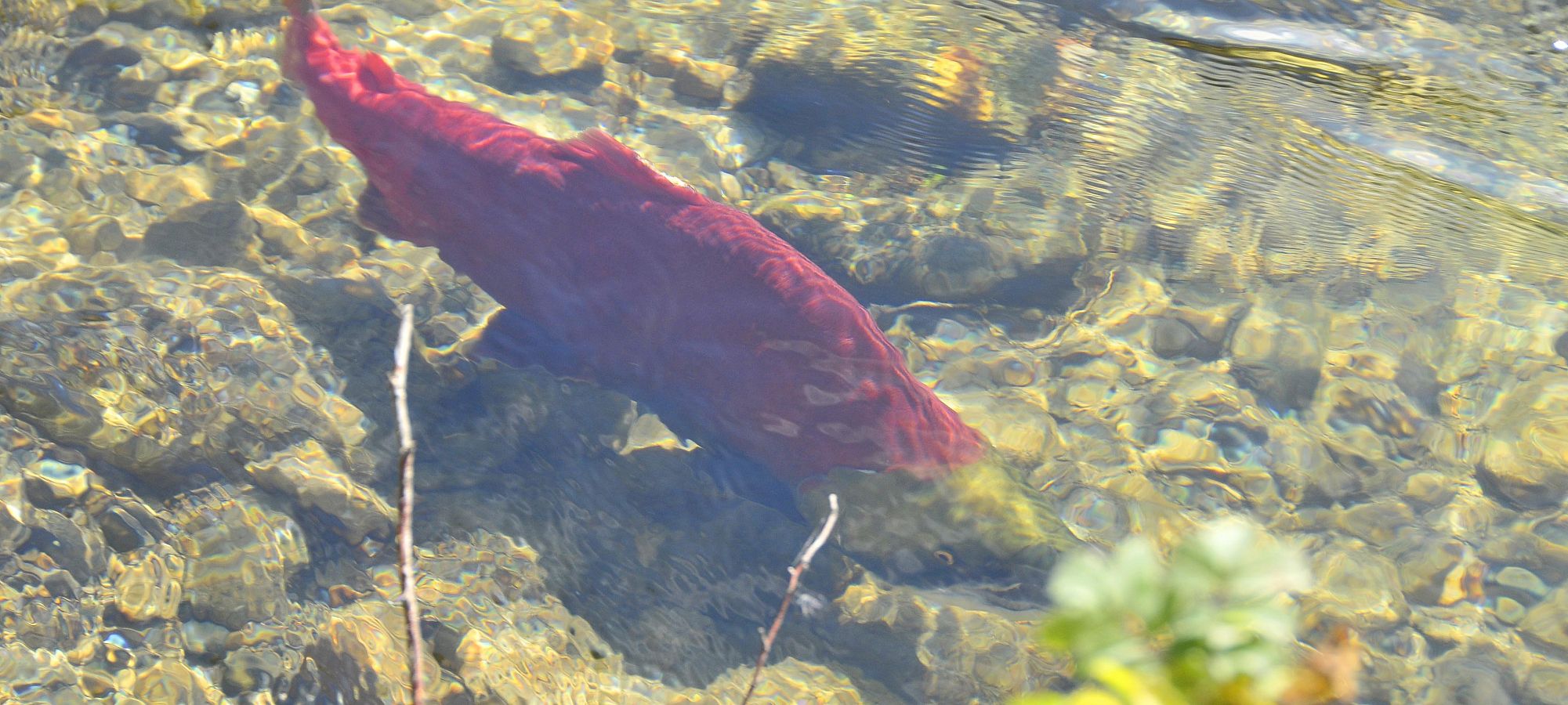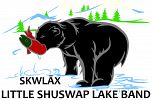

life and death on the river
Salute to the Sockeye 2018

Posted November 5, 2018
The spectacular salmon
I have to admit that some of these pictures are a bit deceptive.
Like the one of the hook-jawed male sockeye salmon. He’s finning in the current while another male swims by in the background. The fish look like they are in fairly deep water, waist-deep at least, and compared to the rocks on the bottom, they seem smallish.
Those things, of course, are illusions caused by the fact that my camera was under water. This side pool in the Adams River in Tsútswecw Provincial Park at the west end of B.C.’s Shuswap Lake held several dozen sockeye salmon and did actually fall off into deeper water.
But the fish in the foreground was in water that was knee-deep at most and within two metres of the shore. The rocks in the foreground were bigger than my fist. The fish itself was as long as my arm and as thick as my leg. My little GoPro camera — on the end of a painter’s extension pole — provided some of the distortion and the light transmission characteristics of water versus air did the rest.

Male sockeye salmon fins in the Adams River at Tsútswecw Provincial Park near Chase, B.C., on Tuesday, October 2, 2018. Mike Drew/Postmedia
These sockeye salmon are big and they like shallow water. And here in the Adams River, there are thousands of them.
Sockeye salmon have a four-year life cycle. They hatch from nests — called redds — in the gravel of mountain streams, spend a year there and then head down to the Pacific Ocean where they grow and mature. In their fourth year, they leave the salt water and enter the streams that flow out to the coast to begin their migration to the waters of their birth.
They essentially begin to die as soon as they leave the sea. They stop eating and their bodies begin to change. Scales fall off and the pigments in their skin start to darken and turn red. The males, pretty much identical to the females out in the ocean, develop humped backs, hooked jaws and wolf-like teeth.

A female sockeye salmon fins in the current of the Adams River at Tsútswecw Provincial Park near Chase, B.C., on Sunday, September 30, 2018. Mike Drew/Postmedia
The sockeye in the Adams River and surrounding streams like nearby Scotch Creek travel up the Fraser River from its mouth at Vancouver and veer off into the Thompson River drainage. Some of them keep going up the North Thompson while others remain in the Fraser River with destinations further upstream.
There are various runs of sockeye salmon in the Fraser drainage, at least one every year, but every four years a gigantic run of sockeye enters the system. This year’s run, one of the dominant runs, holds around 14 million — yeah, that’s right, 14 million — fish. And of those, a huge number will end up in the Adams River.
Where they will spawn. And die.

The Adams River in TsËtswecw Provincial Park near Chase, B.C., on Tuesday, October 2, 2018. The Adams River is world famous for its salmon spawning runs. Mike Drew/Postmedia
My pals Leah and Hunter and I headed out there to see the spectacle but as luck would have it, we went a little bit early. There were still thousands of salmon in the river but they were well scattered with pockets of them finning in the eddies in the main river but very few in the side channels where they actually spawn. In another week or so, the river will be red with them.
Not that it mattered. Wandering through the temperate rainforest full of mossy cedars and mushrooms, exploring our way along the river bank, Hunter leaping like a gazelle, Leah mostly keeping up and me stopping to pretend to take pictures while I caught my breath was plenty of fun despite the slight paucity of fish.
Not that there weren’t fish to see. We sent Hunter out to scout and he found fish pretty much everywhere. Photographing them from above the water was pretty tough. The weather was rainy and overcast and the glare on the water made them tough to see but with the GoPro we managed to get a few pictures of them in their underwater element.
The weather, though, made the forest look spectacular. Soft light and mist on the river gave it an ethereal glow and deep in the woods like along Huihill Creek, upstream from the park, the bright greens of the ubiquitous moss and soft earth tones of the many varieties of mushrooms seemed to give off their own light.

A lush side channel of the Adams River in Tsútswecw Provincial Park near Chase, B.C., on Tuesday, October 2, 2018. The Adams River is world famous for its salmon spawning runs. Mike Drew/Postmedia
The forests and all the wildlife they host kind of rely on the salmon. Even though the fish themselves use up all their energy making the run to the spawning grounds and expend what little they have left in mating battles and redd-building, there are still a lot of nutrients left in their spent bodies. And there are a lot of spent bodies.
Hunter found a cluster of them snagged in a fallen birch along Scotch Creek. His young eyes spotted them but all three of our noses knew roughly where they were as soon as we walked to the creekside.

Spawned-out and dead sockeye salmon caught in a downed tree in Scotch Creek near Tsútswecw Provincial Park near Chase, B.C., on Tuesday, October 2, 2018. Scotch Creek is near the Adams River, world famous for its salmon spawning runs. Mike Drew/Postmedia
Some of the bodies were hanging among the submerged branches while others were moving slowly where they floated in an eddy along the bank. They were grim but fascinating and actually quite beautiful in their own grotesque way. Stuck there against the tree they were decomposing slowly, releasing their nutrients into the water where they would eventually be recomposed into bankside vegetation like the fleabane, alders, birches, cottonwoods and cedars growing close by.
Other bodies lay on the shore of Shuswap Lake, washed there by the outflow from the Adams River and washed up onto the sand. Gulls screeched and squabbled over the bodies but scattered whenever a bald eagle swooped in to join the feast. Grebes and loons swam just off shore looking for the fish that come to join the shoreline birds while kingfishers, ravens and crows flew overhead.

A spawned-out and dead male sockeye salmon on the shore of Shuswap Lake near the mouth of the Adams River in Tsútswecw Provincial Park near Chase, B.C., on Tuesday, October 2, 2018. The Adams River is world famous for its salmon spawning runs. Mike Drew/Postmedia
Human fishers joined the party, too, though they were looking for something other than salmon. Rainbow trout and Dolly Varden char move out of the big lake to throng the river where they gorge on all the salmon eggs that inevitably get scattered to the currents as the salmon jostle and disturb previous nests.
Everything here benefits from the salmon and on the Adams River the salmon-centred web of life is easy to see. The salmon are born here and here they die, generation after generation, each adding another strand to the web. From the trees and shrubs, from the flowers to the berries, from the birds in the sky to the fish in the lakes and streams to the people that come to see them, salmon lie at the base of it all.

Fish bones in the forest along the Adams River near Tsútswecw Provincial Park near Chase, B.C., on Tuesday, October 2, 2018. The Adams River is world famous for its salmon spawning runs. Mike Drew/Postmedia
This is the largest salmon run in North America and Tsútswecw Provincial Park draws visitors from all over the world. To help co-ordinate all the visitors and make sure they can safely and easily view this natural spectacle, the Adams River Salmon Society hosts an event called Salute To The Sockeye to coincide with the four-year dominant run cycle. This year the event runs through the month of October. The peak of the sockeye run is expected around the middle of the month.
So maybe a few of these pictures are a bit deceptive. Lens distortion, light transmission and point of view can kind of skew the vision. But the experience of the Adams River sockeye run is not deceptive at all.
It is an experience that should not be missed.






